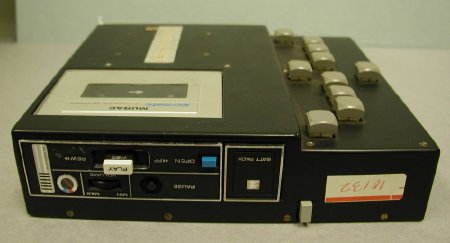Object ID:
1992.283a-b
Title:
Elinfa Digicassette and adapter
Description:
Digicassette "records and stores braille characters on magnetic tape cassette from braille keyboard; plays back braille onto a twelve cell refreshable braille display; operates with optional adaptable electronic calculators, typewriter, or a computer interface; also records and plays back auditory information as a standard cassette tape recorder/player. It was available through Elinfa, Inc., Washington, D.C. Device weighs 4 lbs., includes character by character correction, a touch operated switch for reading board, uses 120 volts AC and/or rechargeable nickel-cadmium batteries. Adapter for the digicassette allows operation with electronic calculators, typewriters or computers.
a - digicassette
b - adapter
a - digicassette
b - adapter
Date:
ca. 1979
Made by:
Tretiakoff, Oleg; Murac Micromatic
Place of Origin:
France
Provenance:
Developed by Oleg Tretiakoff 1975-1977, the Digicassette combined a piezoelectric reed style braille display with a cassette tape storage system. See U.S. Patent 4044350. Some sources, including technology pioneer Deane Blazie, call Tretiakoff's device the first piezoelectric braille display. Tretiakoff negotiated with Telesensory in the U.S. to sell the machine in the U.S. but after those talks broke down, Telesensory developed a similar device which became the VersaBraille. So-called "cassette braille" was slow, expensive, and unreliable, but their piezoelectric cells became the dominant braille display technology over the next decade and whetted the appetites of consumers for better machines. Tretiakoff went on to work for Humanware.
Credit Line:
Gift of George Peabody College for Teachers, 1992.283
